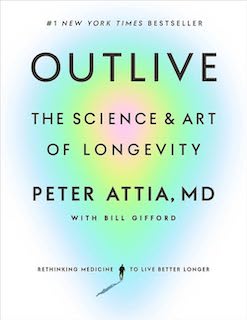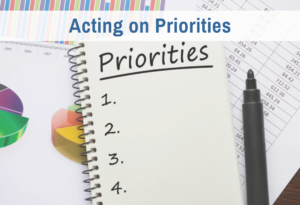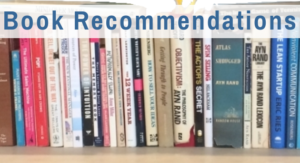I purchased Outlive by Peter Attia just a few weeks ago. As a result of reading it, I have already materially upgraded my diet and exercise regimes. The book gave me a new clarity about my health priorities, which created instant motivation.
I recommend Outlive to you, my readers, in part because you are generally interested in self-improvement, but also because I think you’ll appreciate the individualistic, logical, value-oriented approach the author takes.
Distinguishing healthspan from lifespan
The book focuses on healthspan rather than lifespan per se. Healthspan is the period of your life in which you can maintain a mentally and physically active lifestyle.
Do you want to live longer? I do, but only if I can be mentally and physically active during those extra years. Having seen some older friends and relatives decline mentally and linger in a nursing home for many years, I know that’s the last thing I want. And having had a couple of minor injuries that kept me off a tennis court for months, I am exquisitely aware of how fragile an active lifestyle can be.
Peter Attia shocked me with the statistics of how many people have a bad 5-10 year end of life — especially now, given that modern medicine is designed to keep people alive as long as possible. Based purely on statistics, it’s more likely than not.
But of course, statistics are not a prediction of anything. The main message of the book is that you can influence your healthspan, but to do so, you need to put in effort now to prevent and/or delay the four most problematic diseases that lead to horrible final years: Diabetes, Heart Disease, Cancer, and Senility.
In the book, he explains how these four diseases are interrelated. For example, if you become inactive and weak due to cancer or heart disease or diabetes, you can expect a mental decline to follow forthwith. If you don’t hold the full context of how one treatment affects another area, you can inadvertently shoot yourself in the foot.
Tipping points
Given this context, what really got my attention was his description of the tipping points involved in diabetes and atherosclerosis.
Something like half the population is at risk for diabetes, meaning that they are starting to become insulin-resistant and starting to store fat where it shouldn’t be stored such as in the liver. They don’t process glucose normally, but the body adjusts, by hook or by crook, to keep them functioning — until suddenly it doesn’t. Then your blood sugar goes crazy and you get a Type II diabetes diagnosis. And at that point, you are in real trouble, healthwise, because you are doomed to more and more health problems.
Once you reach the tipping point, it is no longer possible to undo the damage. Earlier on, you can, with appropriate diet and exercise, change your metabolism back to a normal metabolism, and get rid of that mis-stored fat. For most of your life, you can reverse the gradual process, but if you wait too long, you lose that opportunity.
Similarly, fatty buildup in your arteries starts early and can go on for a long time, with the body attempting to adjust. One of these adjustments is to calcify the buildups. Once that calcification occurs, there is no way to remove the buildup. That’s the last phase of the body trying to adapt to the problem.
Before it calcifies, you can reduce the buildup in the arteries through treatment. Diet and exercise interventions that help prevent diabetes can help with this, too, as can certain medications.
I appreciated Attia’s explaining the causes. He makes it clear why it’s important to address these issues early, while the body is still able to adapt and manage.
Most people who give advice on diet and exercise share their conclusions and give only statistical justifications. And of course, if you know How to Lie with Statistics, you can prove almost anything. Attia challenges many sacrosanct statistics and relies on causal analysis for his arguments.
Thinking about your individual situation
This methodology permits a radically different approach to the subject than I’ve seen elsewhere. Because he focuses on causes, Peter Attia can take on an exceedingly complex subject, explain it in terms of essentials, and draw principles to guide action. In other words, rather than telling you rules to follow or making blanket recommendations for everyone, he explains how to apply those principles to your individual situation.
If you want to be spoon-fed pieces of advice that you should follow without question, this book is not for you. On the other hand, if you want a clearer understanding of the complex issues involved in health, so you can have better judgment making decisions for yourself, this is exactly what you’ll get.
For example, Attia does a great job of demystifying the bizarre and often contradictory diet advice that’s out there. Along the way, he debunks a lot of epidemiological studies, but also makes clear what we do know. For example, rather than entering the “diet wars,” he focuses on the important questions to answer:
- Are you undernourished or overnourished?
- Are you undermuscled or adequately muscled?
- Are you metabolically healthy or not?
(These are the issues that can be addressed with diet.)
Then he explains the three kinds of diet: caloric restriction (limiting total calories), dietary restriction (cutting out specific foods), and time restriction (intermittent fasting) — and how these help or hinder addressing the issues.
Personally, he gave me a much deeper appreciation of why I would benefit from taking my diet more seriously. Now I understand why a particular diet is good for my healthspan — not just to wear smaller clothes. The diet that is good for me might not be good for you.
I got similar clarity with respect to exercise. Attia discusses the different kinds of body training — including a type of postural training that I had never heard of — and helped me understand why you would want a variety of exercise.
By giving me the full context, what Attia did was to give me a much deeper understanding about what my body needs if I want to keep playing tennis until I’m 100.
Understanding = new priorities
The immediate effect of reading the book was that my priorities shifted. That’s what happens when you more fully understand all of the causal factors involved in something.
For example, I had been off my regular exercise routines for 6 weeks due to a wrist injury. I could neither play tennis nor do most of my strength-training routine. I had fallen back on just walking for exercise.
Why? Because I saw my commitment to exercise as a commitment to particular activities that I like and value, not as a commitment to my healthspan. As soon as I read the book, I realized that this “temporary condition” of not exercising was a problem I wanted to solve.
I solved it in part by easing back into strength training and in part by adding stationary cycling to my exercise repertoire. It took effort and creativity to get cycling to be a good enough experience that I am happily willing to do it; it wasn’t at that level to begin with. But because my priorities had shifted, I was willing to put in the mental effort needed to make bicycling palatable.
Similarly, I already knew the best diet for me. It’s relatively high protein and relatively low carb. I can stick with it for months at a time, once my taste buds adjust. I have good energy and I don’t even crave carbs when I’m on it. But I don’t stay on it continuously, because it still requires a little too much attention.
But I’ve noticed that when it’s not my #1 priority, the occasional lapse into stress-induced emotional eating will inevitably kill that diet by making my taste buds want sugar again. That’s the problem that I am now working to solve — something I had previously ruled out as not my priority.
What Peter Attia showed me is that if I want to counter the “inevitable” effects of aging, coasting physically or mentally is the problem. Some degradation in your capacities is inevitable; to have a long healthspan, you need to continuously work to improve your mental and physical functioning.
I’ve always been committed to continuing mental improvement. Now I’m on that same premise regarding my body. That’s a dramatic shift from reading a book.








Many thanks.
I got on the floor and did my pushups after reading. Thank you for all the work you do. My life is better for having spent time doing the activities in Thinking Directions.